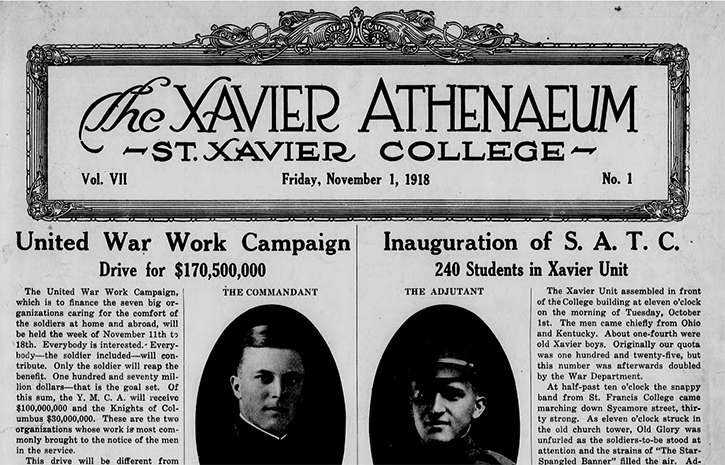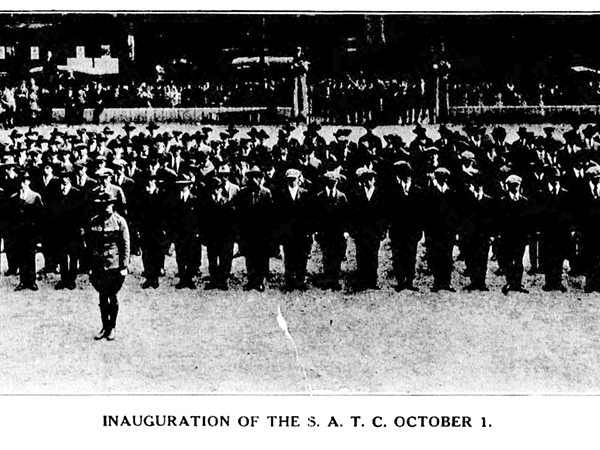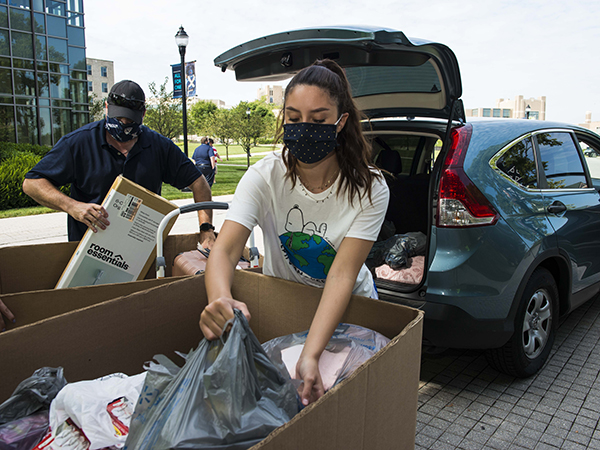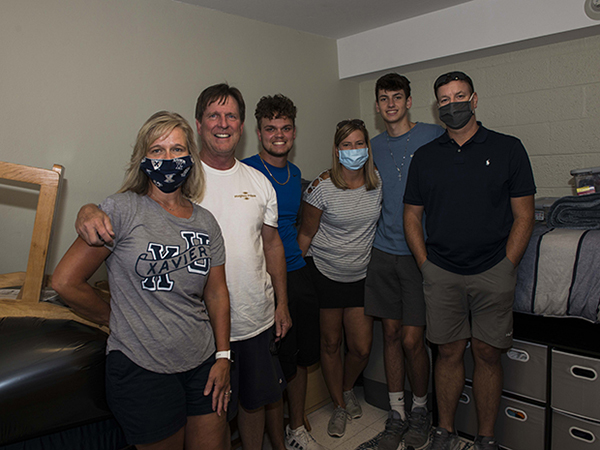
'This Dread Disease'
Sep 21, 2020
Xavier Remembers the Past to Avoid Complacency in the Present
The city was afraid.
An epidemic was raging, and it had arrived on Xavier’s campus. Students were given masks and quarantined. Visitors were screened before entering buildings.
Classes were interrupted.
And still, the disease spread. More than 40 students were infected in one residence hall alone.
Sound familiar? It does — but this incident occurred in October 1918, during the outbreak of Spanish Flu.
While it seems as though this could’ve easily been a description of Xavier classes in the spring or fall of 2020, these scenarios have occurred several times over the past two centuries. And Xavier archivists, media, faculty and students were there to describe each instance.
The Cholera Outbreak
In the 19th century it was cholera, an infection of the small intestine, and it ran rampant in Cincinnati in the 1840s, helping to cause a decline in University enrollment.
“The year 1848-1849 had experienced a decided falling off in the attendance, and the steady decrease continued for several years,” The Xavier Athenaeum from February, 1916, reported. “One cause of this was undoubtedly the opening of the Jesuit Boarding College at Bardstown, Kentucky in 1848 and the flourishing condition of other Jesuit colleges at Louisville, Grand Coteau and Spring Hill. Perhaps another contributing cause was the cholera epidemic in Cincinnati at this time. The first appearance of this dread disease in Cincinnati in the year 1849 brought about a remarkable manifestation of devotion to the Queen of Heaven.”
Students met, and they made a vow to the Blessed Virgin.
“If all the students were preserved from death by the cholera during its prevalence in the city they would have two golden crowns made, one for the Blessed Virgin and one for the Infant Jesus, to be placed on their respective images in the chapel,” the article stated.
And that’s what they did.
It is estimated that 50,000 Americans died from the disease, including one Xavier student and two members of the faculty. Earlier in the outbreak, in 1832, Bishop Edward Fenwick himself died from the disease, at the age of 64.

The Spanish Flu
During the first World War, specifically in the fall of 1918, Xavier created its own arm of the SATC, or the Student Army Training Corps, which was a War Department program that hastened the training of soldiers on college campuses. Students would take classes and simultaneously train for the military, and they lived in their own barracks at the Fenwick Club, noted Lee J. Bennish, in his 1981 book, Continuity and Change: Xavier University, 1831-1981.
“Two hundred and thirty-two young men chiefly from the Ohio and Kentucky area arrived, and the entire college program was adapted to meet the needs of the future army officers,” Bennish wrote. “Eleven Jesuits and twelve non-Jesuits, including one woman, formed the teaching faculty.”
They would drill along Reading Road, and march to and from their classes, which began Oct. 1, 1918.
Coincidentally, it was around the same time that the Spanish Flu, a strain of the H1N1 virus, began ravaging Cincinnati.
Five days after classes began, the flu broke out in the barracks.
“Every precaution was taken to keep the disease from gaining admittance and spreading,” the Athenaeum reported. “’Gas masks’ — cloth masks to cover the nose and mouth — were issued, and antiseptic tablets, to be used as a gargle, were distributed thrice daily. As a result of these measures only forty-six of the men contracted the disease — thirty-eight cases of which were so mild as to permit the victims to be about in a very short time.”
The article went on to praise Dr. Joseph DeCourcey, the five Sisters of Charity, the four Good Samaritan nurses and the five patriotic members of the unit, “all of whom were in constant attendance.”
Theirs was the only unit in Cincinnati not to suffer a fatality.
“To express our appreciation to the Blessed Virgin for her intercession to God to protect us from the sorrows of death during the epidemic, a bronze tablet is to be placed on the chapel wall at the Fenwick Club as a memorial of Our Lady’s protection,” the article stated.
A little more than two weeks later on Oct. 23, the battalion resumed their drills and classwork. The flu would kill an estimated 50 million people, including 500,000 Americans.
“The flu rocked the city of Cincinnati in the fall and winter of 1918,” Fr. Thomas Kennealy, S.J., noted in a 2018 lecture for the University Archives. He noted that one high school student, and one St. Xavier Commercial School student died of the flu. “Probably pretty lucky it was not more,” he said. “The pandemic was really an episode that people and time surely will not forget.”

The Swine Flu (H1N1)
More recently, student officials had to contend with the Swine Flu, also known as H1N1.
A virus that actually does come from pigs, the pandemic lasted about 19 months in 2009 and 2010. It was the second H1N1 strain pandemic after the Spanish Flu.
Nearly 300,000 people died worldwide — including 12,000 Americans.
As students came back to Xavier for the start of school in August 2009, dozens of students developed symptoms of the illness, and seven students were quarantined, according to a story in The Kentucky Post newspaper.
“University officials have designated an isolation area for infected to students in the basement of its Alumni Center,” the article stated. “The building has separate ventilation systems for each floor.”
In the president’s Welcome Back letter to the campus community on Aug. 25, 2009, Fr. Michael J. Graham, S.J., noted the preparations being taken to combat the possibility of the flu spreading.
“For example, hand sanitizers are more available across campus,” he said. “At this time, the University has no plans to limit visitors to campus or to disrupt classes or planned activities. We are doing everything we can to keep our institutional operating as usual. For now, the University is urging members of the campus community to be aggressive in their vigilance of hygienic practices.”
One student, Taylor Neal, tested positive and told the newspaper she was told to stay home off-campus. She described her symptoms as similar to the seasonal flu.
“I had a sore throat and a cough, and a really bad headache," she said. "I have to stay in my room for all the time I have a fever, and 24, but preferably 48 hours after it goes away. If I come out of my room into the rest of the house, I have to wear a mask.”
Other students were seen wearing masks as they walked around campus, and the University did their best to limit large gatherings of people. In the fall of 2009, vaccines were administered, and by the start of the school year in 2010, the World Health Organization declared the pandemic over.

What We Learn
Karim Tiro, PhD, is a professor in Xavier’s Department of History. This semester, he is teaching a course entitled “History of Epidemic Disease,” and he says it is important to remember these stories because forgetting them could result in the development of a sense of complacency.
“For me, what we get from looking at past examples of epidemics is a reminder that sudden disease outbreaks wreaked havoc in Americans’ lives until only about a century ago,” Tiro said. “Since those events are now beyond the living memory of nearly everyone, it’s easy to be complacent and let down our guard. Hopefully, history can inoculate us against amnesia and its dangerous effects.”
One of the ways Xavier is making sure people will not forget is with the COVID-19 & Xavier: A Digital Collection project. In an attempt to capture and document the impact of the virus on the Xavier community, as well as our response to the challenges it poses, University Archives is asking for stories, photos and other contributions.
Project contributions will help future scholars — and to some extent, current ones — understand the social, economic and organizational effects of the pandemic on our students, faculty, staff and alumni of Xavier.
And how did the idea come about? By researching the pandemics of yesteryear.
“I began work on the digital collection during the first week of March when we started getting more announcements from the President and the administrators regarding their monitoring of the situation,” collection director and founder Anne Ryckbost told the Newswire. “What I’m hoping is that students, faculty, staff and alumni can go on the libguides page and use the contribution submission form to submit reflections, blog posts, videos or social media posts of their own so that we get a diverse representation of what the Xavier experience was like during this time.”
There are dozens of questions and things to think about. How did we feel about this rapidly changing environment? What was it like to work from home? How did All for One and One For All play out in our experience?
“I think it’s going to be used to study a couple of things,” Ryckbost said. “It’s going to be used to study our social and cultural experiences of this period. How did we connect and build community? What was disrupted and what was continued? In 20 to 50 years, we’ll be looking back at this pandemic trying to understand what the implications of it were.”
To learn more and to contribute, visit the project website. Questions? Contact Anne Ryckbost, University Archives and Special Collections, at ryckbosta@xavier.edu.
— By Ryan Clark, Office of Marketing and Communications